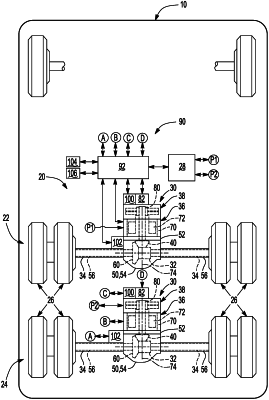| CPC B60L 15/2054 (2013.01) [B60K 1/02 (2013.01); B60L 7/18 (2013.01); B60L 15/20 (2013.01); B60L 15/2045 (2013.01); B60L 58/10 (2019.02); F16H 61/16 (2013.01); B60L 2240/545 (2013.01)] | 20 Claims |

|
1. A method of controlling a drive axle system, the method comprising:
determining a regeneration power limit and a regeneration current limit of an electric power source of the drive axle system, the drive axle system including a first axle assembly having a first transmission and a first electric motor that is configured to provide torque to the first transmission, and a second axle assembly having a second transmission and a second electric motor that is configured to provide torque to the second transmission, wherein the first electric motor and the second electric motor are electrically connected to the electric power source; and
providing regeneration torque with the first electric motor to the first transmission to reduce a rotational speed of a gear of the first transmission and providing increased propulsion torque with the second electric motor to the second transmission in preparation for a gear upshift of the first transmission;
determining whether the regeneration power limit of the electric power source is reached when providing regeneration torque, and providing regeneration torque with the first electric motor without exceeding the regeneration power limit when the regeneration power limit is reached; and
determining whether the regeneration current limit of the electric power source is reached when providing regeneration torque and providing regeneration torque with the first electric motor without exceeding the regeneration current limit when the regeneration current limit is reached.
|